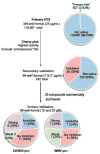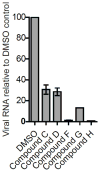High-throughput screening for the identification of small-molecule inhibitors of the flaviviral protease
- PMID: 27539384
- PMCID: PMC5065773
- DOI: 10.1016/j.antiviral.2016.08.014
High-throughput screening for the identification of small-molecule inhibitors of the flaviviral protease
Abstract
The mosquito-borne dengue virus serotypes 1-4 (DENV1-4) and West Nile virus (WNV) cause serious illnesses worldwide associated with considerable morbidity and mortality. According to the World Health Organization (WHO) estimates, there are about 390 million infections every year leading to ∼500,000 dengue haemorrhagic fever (DHF) cases and ∼25,000 deaths, mostly among children. Antiviral therapies could reduce the morbidity and mortality associated with flaviviral infections, but currently there are no drugs available for treatment. In this study, a high-throughput screening assay for the Dengue protease was employed to screen ∼120,000 small molecule compounds for identification of inhibitors. Eight of these inhibitors have been extensively analyzed for inhibition of the viral protease in vitro and cell-based viral replication using Renilla luciferase reporter replicon, infectivity (plaque) and cytotoxicity assays. Three of these compounds were identified as potent inhibitors of DENV and WNV proteases, and viral replication of DENV2 replicon and infectious RNA. Fluorescence quenching, kinetic analysis and molecular modeling of these inhibitors into the structure of NS2B-NS3 protease suggest a mode of inhibition for three compounds that they bind to the substrate binding pocket.
Keywords: Fluorescence quenching; High-throughput screening; Protease inhibitors; Renilla luciferase reporter replicon; Therapeutic index; Virus infectivity assays.
Copyright © 2016 Elsevier B.V. All rights reserved.
Figures







Similar articles
-
Strategies Towards Protease Inhibitors for Emerging Flaviviruses.Adv Exp Med Biol. 2018;1062:175-186. doi: 10.1007/978-981-10-8727-1_13. Adv Exp Med Biol. 2018. PMID: 29845533 Free PMC article. Review.
-
Effects of NS2B-NS3 protease and furin inhibition on West Nile and Dengue virus replication.J Enzyme Inhib Med Chem. 2017 Dec;32(1):712-721. doi: 10.1080/14756366.2017.1306521. J Enzyme Inhib Med Chem. 2017. PMID: 28385094 Free PMC article.
-
Small molecule pan-dengue and West Nile virus NS3 protease inhibitors.Antivir Chem Chemother. 2011 May 12;21(5):209-17. doi: 10.3851/IMP1767. Antivir Chem Chemother. 2011. PMID: 21566267 Free PMC article.
-
Amodiaquine, an antimalarial drug, inhibits dengue virus type 2 replication and infectivity.Antiviral Res. 2014 Jun;106:125-34. doi: 10.1016/j.antiviral.2014.03.014. Epub 2014 Mar 27. Antiviral Res. 2014. PMID: 24680954 Free PMC article.
-
Orthoflaviviral Inhibitors in Clinical Trials, Preclinical In Vivo Efficacy Targeting NS2B-NS3 and Cellular Antiviral Activity via Competitive Protease Inhibition.Molecules. 2024 Aug 27;29(17):4047. doi: 10.3390/molecules29174047. Molecules. 2024. PMID: 39274895 Free PMC article. Review.
Cited by
-
Updates on Dengue Vaccine and Antiviral: Where Are We Heading?Molecules. 2021 Nov 9;26(22):6768. doi: 10.3390/molecules26226768. Molecules. 2021. PMID: 34833860 Free PMC article. Review.
-
Reporter Replicons for Antiviral Drug Discovery against Positive Single-Stranded RNA Viruses.Viruses. 2020 May 30;12(6):598. doi: 10.3390/v12060598. Viruses. 2020. PMID: 32486283 Free PMC article. Review.
-
Strategies Towards Protease Inhibitors for Emerging Flaviviruses.Adv Exp Med Biol. 2018;1062:175-186. doi: 10.1007/978-981-10-8727-1_13. Adv Exp Med Biol. 2018. PMID: 29845533 Free PMC article. Review.
-
Molecular Mechanisms of Antiviral Agents against Dengue Virus.Viruses. 2023 Mar 8;15(3):705. doi: 10.3390/v15030705. Viruses. 2023. PMID: 36992414 Free PMC article. Review.
-
Targeting the protease of West Nile virus.RSC Med Chem. 2021 May 26;12(8):1262-1272. doi: 10.1039/d1md00080b. eCollection 2021 Aug 18. RSC Med Chem. 2021. PMID: 34458734 Free PMC article. Review.
References
-
- Alcaraz-Estrada SL, Reichert ED, Padmanabhan R. Construction of self-replicating subgenomic West Nile virus replicons for screening antiviral compounds. In: Vasudevan RPaS., editor. Methods Mol Biol. Humana Press, Springer Science +Business Media; 2013. pp. 283–299. 2013/07/04 ed. - PubMed
-
- Beasley DW. Recent advances in the molecular biology of west nile virus. Curr Mol Med. 2005;5:835–850. - PubMed
Publication types
MeSH terms
Substances
Grants and funding
LinkOut - more resources
Full Text Sources
Other Literature Sources

